The sky based communication market, valued at USD 162.8 billion in 2025, is projected to reach USD 1,033.3 billion by 2035, growing at a CAGR of 20.3%. The market exhibits significant volatility in growth rates due to rapid advancements in satellite communication technologies and shifting global demand for improved connectivity solutions. From 2021 to 2025, the market is projected to grow from USD 112.5 billion to USD 162.8 billion, with annual increments reaching USD 135.3 billion, USD 162.8 billion, and USD 195.8 billion. This initial phase shows moderate growth, driven by increasing demand for satellite-based communication services in remote areas, enhanced internet services, and the rise of 5G and IoT applications.
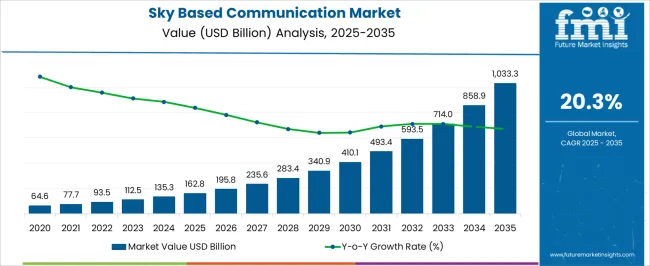
Between 2026 and 2030, the market experiences an accelerated growth trajectory, expanding from USD 195.8 billion to USD 340.9 billion. This period is characterized by technological advancements in low Earth orbit (LEO) satellite networks and increased investments in communication infrastructure, which have contributed to a sharp rise in market value. From 2031 to 2035, the market reaches USD 1,033.3 billion, advancing through USD 410.1 billion, USD 493.4 billion, USD 593.5 billion, and USD 714.0 billion. This final phase reflects strong growth driven by the global shift toward space-based internet services, smart cities, and government-led space initiatives, resulting in substantial volatility and an overall surge in market size as technologies mature and widespread adoption occurs.
| Metric | Value |
|---|---|
| Sky Based Communication Market Estimated Value in (2025 E) | USD 162.8 billion |
| Sky Based Communication Market Forecast Value in (2035 F) | USD 1033.3 billion |
| Forecast CAGR (2025 to 2035) | 20.3% |
The telecommunications market is the largest contributor, accounting for approximately 40-45% of the market. Sky-based communication technologies, such as satellite communication and high-altitude platforms, are increasingly used to extend communication networks, particularly in remote or underserved regions where traditional infrastructure is not feasible. The aerospace and defense market contributes around 20-25%, as sky-based communication plays a vital role in military and defense operations, offering secure, long-range, and reliable communication for surveillance, reconnaissance, and command control. The satellite services market holds about 15-18%, with the growing demand for satellite communication systems that provide global coverage for various applications, including weather monitoring, broadcasting, and navigation. The Internet of Things (IoT) market adds approximately 10-12%, as sky-based communication systems are increasingly used for connecting IoT devices in remote locations, supporting industries like agriculture, logistics, and environmental monitoring. The cloud computing market contributes around 5-8%, as sky-based communication solutions are essential for providing cloud services and data transmission across vast distances, supporting cloud infrastructure and global connectivity.
The sky based communication market is witnessing accelerated expansion, fueled by increasing reliance on satellite-enabled connectivity across multiple sectors. The current scenario is characterized by heightened deployment of satellite constellations, particularly in low Earth orbit, to address bandwidth demand, latency reduction, and global coverage requirements.
Market growth is supported by the convergence of advanced communication technologies with satellite infrastructure, enabling high-speed, secure, and resilient networks. The sector’s progression is further underpinned by governmental investments, private sector participation, and the strategic importance of uninterrupted connectivity for critical operations.
A favorable policy environment, coupled with the expansion of commercial space activities, is enhancing competitiveness and driving innovation in satellite manufacturing, launch services, and communication payload design. Looking forward, increasing adoption in defense, maritime, aviation, and remote area communications is projected to sustain market momentum, while emerging applications in IoT integration and disaster recovery communications will contribute to the market’s long-term value proposition.
The sky based communication market is segmented by type, application, end-user, and geographic regions. By type, sky based communication market is divided into Low Earth Orbit (LEO) and Medium Earth Orbit (MEO). In terms of application, sky based communication market is classified into Telecommunication, Broadband, Navigation, Remote sensing, Broadcasting, and Other applications. Based on end-user, sky based communication market is segmented into Military and government and Commercial. Regionally, the sky based communication industry is classified into North America, Latin America, Western Europe, Eastern Europe, Balkan & Baltic Countries, Russia & Belarus, Central Asia, East Asia, South Asia & Pacific, and the Middle East & Africa.
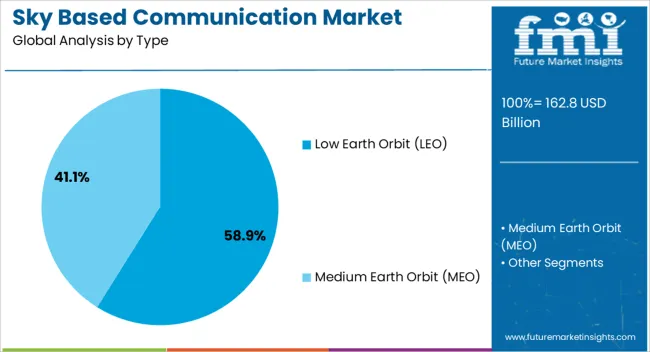
The low Earth orbit segment holds the dominant position within the type category, accounting for approximately 58.9% of the total market share. This leadership is reinforced by the segment’s capability to deliver lower latency, higher bandwidth efficiency, and cost-effective deployment compared to higher orbit alternatives.
The reduced distance from Earth enables more responsive and reliable communication links, making LEO satellites particularly suited for broadband internet delivery, real-time data transmission, and critical connectivity applications. The scalability of LEO constellations and the relatively lower launch costs have further driven adoption, with increased participation from both governmental agencies and private enterprises.
Enhanced interoperability with terrestrial networks has expanded market potential, creating opportunities in mobility, enterprise, and defense applications. With ongoing advancements in satellite miniaturization, propulsion systems, and frequency management, the LEO segment is projected to maintain its market leadership throughout the forecast period.
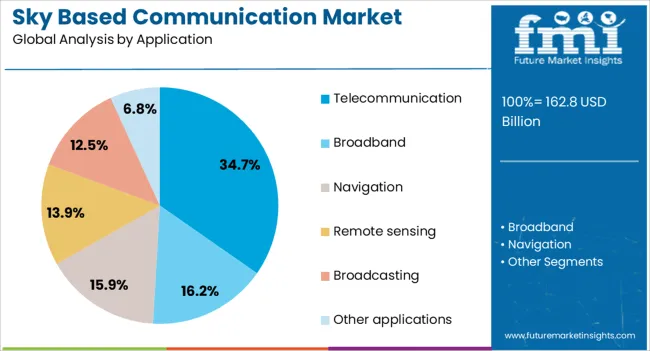
The telecommunication segment represents the largest share in the application category, contributing approximately 34.7% of the sky based communication market. This dominance is driven by the critical role of satellite systems in expanding communication infrastructure to underserved and remote areas. The segment’s growth has been facilitated by the demand for high-capacity, resilient, and geographically flexible networks to support mobile, broadband, and backhaul services.
Integration of satellite technology with emerging 5G infrastructure has positioned this segment as an enabler of next-generation connectivity, enhancing service delivery in both developed and developing markets. Telecommunication operators are increasingly leveraging satellite capabilities to ensure service continuity, disaster recovery, and maritime and aviation connectivity.
The transition toward higher throughput satellites and improved spectrum utilization is further reinforcing market penetration. Sustained investment in satellite communication for broadband expansion is expected to secure the telecommunication segment’s leading share over the forecast horizon.
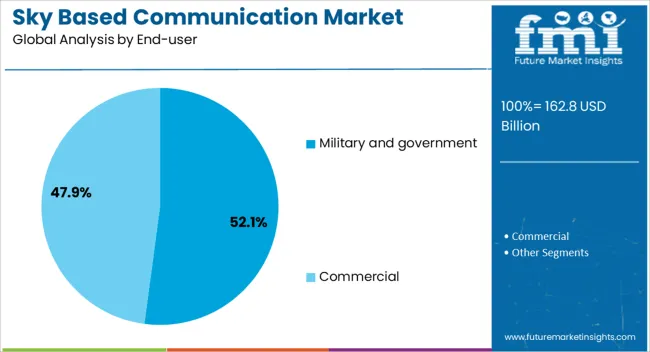
The military and government segment holds the highest share within the end-user category, accounting for approximately 52.1% of the market. This segment’s prominence stems from the critical need for secure, reliable, and resilient communication channels to support defense operations, surveillance, and national security initiatives. Sky based communication systems are integral to command-and-control infrastructure, enabling real-time intelligence sharing, mission coordination, and disaster response capabilities.
The segment benefits from sustained governmental budgets and strategic investments in satellite networks that ensure operational autonomy and secure data transmission. Additionally, advancements in encryption, anti-jamming technologies, and interoperability with allied systems have strengthened the utility of satellite communication in defense applications.
Government agencies also rely on these systems for civil protection, environmental monitoring, and emergency services, further expanding their application scope. With geopolitical considerations and defense modernization programs driving demand, the military and government segment is expected to maintain its leading position in the market over the forecast period.
The sky-based communication market is experiencing rapid growth due to the increasing demand for high-speed, reliable communication systems for remote and underserved areas. The market is driven by advancements in satellite and high-altitude platform station (HAPS) technologies, which enable continuous and seamless connectivity for industries such as telecommunications, defense, aviation, and maritime. Challenges include the high cost of satellite infrastructure, regulatory complexities, and the need for efficient spectrum management. Opportunities lie in the integration of sky-based communication with 5G networks, providing enhanced connectivity in rural and hard-to-reach areas. Trends indicate a growing shift toward low Earth orbit (LEO) satellite constellations and the use of HAPS to provide low-latency, high-bandwidth services.
The demand for sky-based communication systems is being driven by the need for reliable, high-speed internet connectivity in remote and underserved regions. Satellite-based communication, including low Earth orbit (LEO) satellites, is becoming a vital solution for providing internet services in areas where traditional ground-based infrastructure is limited or unavailable. Industries such as telecommunications, defense, and maritime are adopting sky-based communication systems to enhance communication reliability and data transfer speeds. As the global push for digital inclusion continues, the market for sky-based communication is expected to expand, particularly in rural areas where terrestrial broadband infrastructure is limite
The sky-based communication market faces several challenges, primarily the high initial capital investment required for satellite infrastructure, launch services, and maintenance. The development and deployment of satellites, particularly LEO constellations, require significant financial resources, making it a barrier for smaller companies or startups to enter the market. Regulatory hurdles related to frequency spectrum allocation, international coordination, and compliance with space laws are also constraints that could slow market growth. The technical challenges of ensuring consistent, low-latency performance, mitigating interference, and maintaining the durability of satellites or HAPS in space or the stratosphere are significant factors impacting market development. These challenges highlight the need for robust partnerships and technological innovations to drive growth in the market.
A significant opportunity in the sky-based communication market lies in the integration with 5G networks to enhance global connectivity. Sky-based systems, such as satellites and HAPS, can provide a complementary layer to 5G infrastructure, particularly in remote or hard-to-reach areas where traditional towers are not feasible. The ability to offer seamless, low-latency communication for rural, maritime, and aviation sectors presents new growth prospects. Moreover, as demand for global connectivity continues to rise, sky-based communication systems are positioning themselves as critical components for delivering uninterrupted communication services. Companies developing integrated, cost-effective solutions to combine sky-based communication with 5G will be well-positioned to capitalize on this expanding market.
The market is increasingly focused on the development and deployment of low Earth orbit (LEO) satellites and high-altitude platform stations (HAPS), as they offer faster, more reliable communication services with lower latency compared to traditional geostationary satellites. LEO satellites, in particular, are being used in large constellations to ensure continuous global coverage, especially in remote or underserved regions. HAPS, which operate in the stratosphere, are also emerging as a promising solution for providing high-bandwidth connectivity for specific areas or regions. These advancements are enabling better connectivity for sectors such as aerospace, maritime, and defense, as well as for rural broadband services. As technology continues to improve, the adoption of LEO satellites and HAPS will likely become a dominant trend in the sky-based communication market.
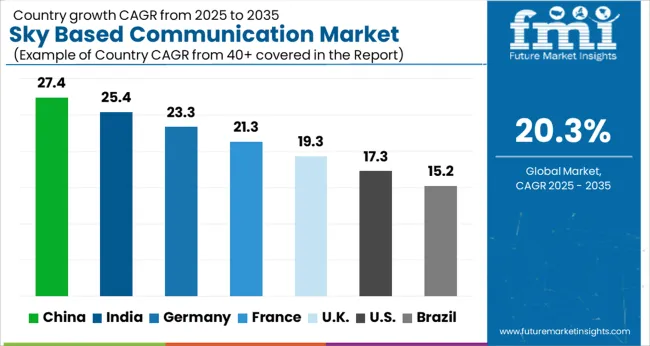
| Country | CAGR |
|---|---|
| China | 27.4% |
| India | 25.4% |
| Germany | 23.3% |
| France | 21.3% |
| UK | 19.3% |
| USA | 17.3% |
| Brazil | 15.2% |
The global sky-based communication market is expected to grow at a CAGR of 20.3% from 2025 to 2035. China is leading the market at 27.4%, followed by India at 25.4%, and Germany at 23.3%. The growth is driven by expanding satellite infrastructure, increasing demand for global connectivity, and rising applications in industries like telecommunications, defense, and IoT. As space-based communication systems become more integrated into critical infrastructure, countries are investing heavily to improve connectivity, especially in remote and underserved areas. The UK and USA are also seeing strong growth due to technological advancements and private-sector involvement in space exploration. The analysis spans over 40+ countries, with the leading markets shown below.
The sky-based communication market in China is expected to grow at a CAGR of 27.4% from 2025 to 2035, driven by rapid advancements in satellite communication technology and the increasing demand for reliable, global connectivity. China’s large-scale infrastructure projects and growing satellite launch capabilities are fueling the country’s market growth. As the government invests heavily in the development of satellite constellations and space-based communication systems, the demand for sky-based communication technologies is on the rise. The country’s focus on expanding internet connectivity across rural and remote areas through satellite services is also contributing to market expansion. With the growing demand for data transmission for both commercial and governmental sectors, the need for advanced communication technologies, including sky-based solutions, is accelerating. China’s strategic collaborations with global space agencies further strengthen its position in the satellite communication market, ensuring the growth of its space-based communication sector.
The sky-based communication market in India is expected to grow at a CAGR of 25.4% from 2025 to 2035, supported by the government’s push to develop space and satellite communication technologies. India’s ambitious space missions and growing investments in satellite infrastructure are expected to drive the demand for advanced communication solutions. With the need to expand internet access to underserved and remote areas, India’s reliance on satellite communication technologies is increasing. The growing number of space startups and partnerships with global space agencies is expected to foster the development of new communication technologies. As the country modernizes its telecommunications and broadband networks, satellite-based communication will play a vital role in bridging connectivity gaps. The increasing demand for communication in defense, agriculture, and disaster management is pushing the growth of sky-based communication services.
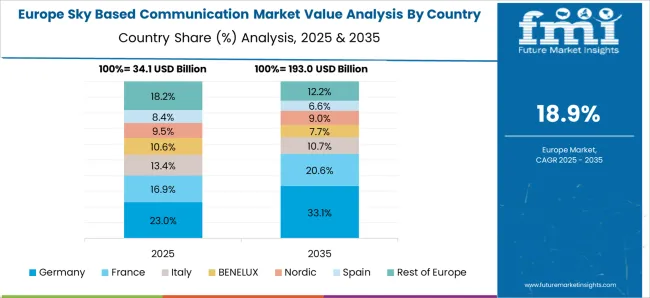
The sky-based communication market Germany is projected to grow at a CAGR of 23.3% from 2025 to 2035, fueled by the country’s ongoing advancements in satellite and space technologies. As Germany is a key player in the European space industry, the demand for sky-based communication systems is rising due to its focus on improving global connectivity and satellite services. The growing interest in satellite communication for telecommunications, transportation, and defense sectors is expected to contribute significantly to market growth. Germany’s support for global space collaborations and its participation in major space missions are increasing the demand for advanced communication solutions. With the rise of IoT (Internet of Things) and the push towards smart cities, satellite communication plays a critical role in providing seamless connectivity.
The UK sky-based communication market is projected to grow at a CAGR of 19.3% from 2025 to 2035, driven by strong government and private sector investments in satellite infrastructure. The UK has been increasing its focus on space-based communication technologies as part of its broader strategy to improve internet connectivity and digital infrastructure. The demand for sky-based communication solutions is rising, particularly in the telecommunications sector, where the need for high-speed and reliable communication channels is increasing. The UK’s space initiatives and collaborations with the European Space Agency and other international partners are expected to accelerate the development of satellite communication technologies.
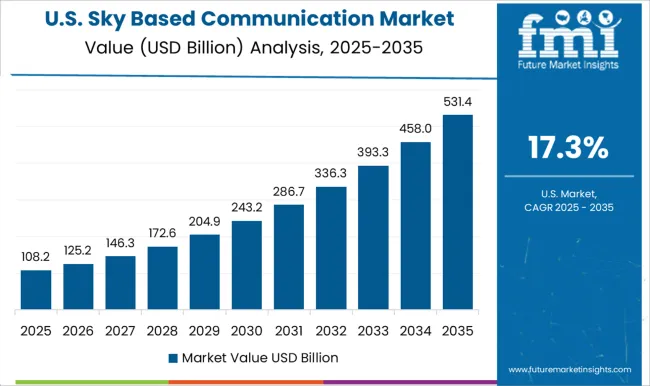
The USA sky-based communication market is expected to grow at a CAGR of 17.3% from 2025 to 2035, supported by ongoing advancements in satellite technologies and a strong demand for communication solutions across various sectors. The USA continues to lead in space-based communication developments, with major companies and government initiatives such as NASA and SpaceX playing pivotal roles. The expansion of satellite constellations, along with rising demand for broadband internet in rural areas, is expected to boost the market. The increasing use of sky-based communication for defense, scientific research, and global data transmission will further fuel market growth.
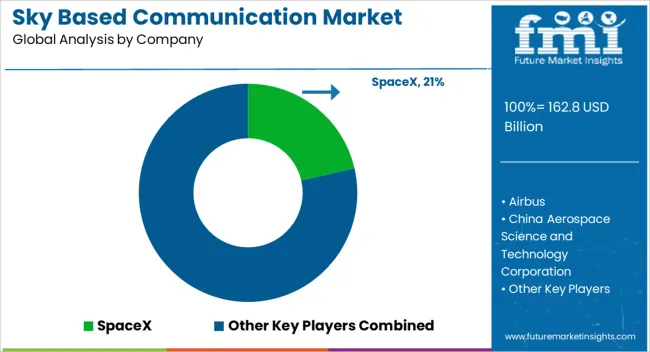
In the sky-based communication market, competition is fueled by advancements in satellite technologies, global connectivity, and the growing demand for broadband and secure communication services. SpaceX leads with its innovative Starlink satellite constellation, designed to provide high-speed internet access to underserved regions worldwide. The company’s focus on reducing satellite launch costs through reusable rockets and rapid deployment has positioned it as a major player in the satellite internet sector. Airbus competes by offering satellite communication solutions for both commercial and defense sectors, leveraging its expertise in satellite manufacturing and orbital technologies. China Aerospace Science and Technology Corporation (CASC) provides robust satellite-based communication services, particularly targeting the Chinese market with a focus on national security and space exploration.
Cobham focuses on providing airborne communication equipment for military, aviation, and commercial sectors. The company offers satellite communication systems that support both fixed and mobile installations, emphasizing ruggedness and reliability. Echostar operates a large fleet of geostationary satellites, competing by providing broadband and communication solutions for both consumer and enterprise markets, while Honeywell offers satellite communication solutions tailored for aviation and aerospace, providing in-flight connectivity, data services, and navigation. Inmarsat and Intelsat dominate the satellite communications space, with extensive networks that offer global connectivity for maritime, aviation, and enterprise sectors. Their focus on high-bandwidth and low-latency solutions has made them leaders in reliable communication systems for remote locations.
Iridium operates a global constellation of low-Earth orbit (LEO) satellites, specializing in mission-critical communication for sectors like defense, aviation, and emergency response. L3Harris provides secure communication technologies, particularly for government and defense applications, while Maxar Technologies offers high-resolution satellite imaging and communications for commercial and government use. Thales and Viasat focus on broadband connectivity solutions, offering cutting-edge communication systems for both civilian and military applications, with a focus on high-speed, low-latency performance. Product brochures highlight satellite constellations, broadband services, secure communication networks, low Earth orbit (LEO) capabilities, and advanced ground systems, offering flexibility and global connectivity to meet the diverse needs of government, defense, aviation, and commercial sectors.
| Item | Value |
|---|---|
| Quantitative Units | USD 162.8 Billion |
| Type | Low Earth Orbit (LEO) and Medium Earth Orbit (MEO) |
| Application | Telecommunication, Broadband, Navigation, Remote sensing, Broadcasting, and Other applications |
| End-user | Military and government and Commercial |
| Regions Covered | North America, Europe, Asia-Pacific, Latin America, Middle East & Africa |
| Country Covered | United States, Canada, Germany, France, United Kingdom, China, Japan, India, Brazil, South Africa |
| Key Companies Profiled | SpaceX, Airbus, China Aerospace Science and Technology Corporation, Cobham, Echostar, Honeywell, Inmarsat, Intelsat, Iridium, L3Harris, Maxar Technologies, Thales, and Viasat |
| Additional Attributes | Dollar sales by communication type (broadband, voice, data), satellite technology (LEO, MEO, GEO), and end-user industry (aerospace, military, telecommunications, maritime). Demand dynamics are driven by the expansion of satellite internet services, the growing need for global connectivity in remote regions, and government investments in defense and space infrastructure. Regional growth is strong in North America, Europe, and Asia-Pacific, with increasing satellite launches and investments in 5G and next-generation communication systems. |
The global sky based communication market is estimated to be valued at USD 162.8 billion in 2025.
The market size for the sky based communication market is projected to reach USD 1,033.3 billion by 2035.
The sky based communication market is expected to grow at a 20.3% CAGR between 2025 and 2035.
The key product types in sky based communication market are low earth orbit (leo) and medium earth orbit (meo).
In terms of application, telecommunication segment to command 34.7% share in the sky based communication market in 2025.






Our Research Products

The "Full Research Suite" delivers actionable market intel, deep dives on markets or technologies, so clients act faster, cut risk, and unlock growth.

The Leaderboard benchmarks and ranks top vendors, classifying them as Established Leaders, Leading Challengers, or Disruptors & Challengers.

Locates where complements amplify value and substitutes erode it, forecasting net impact by horizon

We deliver granular, decision-grade intel: market sizing, 5-year forecasts, pricing, adoption, usage, revenue, and operational KPIs—plus competitor tracking, regulation, and value chains—across 60 countries broadly.

Spot the shifts before they hit your P&L. We track inflection points, adoption curves, pricing moves, and ecosystem plays to show where demand is heading, why it is changing, and what to do next across high-growth markets and disruptive tech

Real-time reads of user behavior. We track shifting priorities, perceptions of today’s and next-gen services, and provider experience, then pace how fast tech moves from trial to adoption, blending buyer, consumer, and channel inputs with social signals (#WhySwitch, #UX).

Partner with our analyst team to build a custom report designed around your business priorities. From analysing market trends to assessing competitors or crafting bespoke datasets, we tailor insights to your needs.
Supplier Intelligence
Discovery & Profiling
Capacity & Footprint
Performance & Risk
Compliance & Governance
Commercial Readiness
Who Supplies Whom
Scorecards & Shortlists
Playbooks & Docs
Category Intelligence
Definition & Scope
Demand & Use Cases
Cost Drivers
Market Structure
Supply Chain Map
Trade & Policy
Operating Norms
Deliverables
Buyer Intelligence
Account Basics
Spend & Scope
Procurement Model
Vendor Requirements
Terms & Policies
Entry Strategy
Pain Points & Triggers
Outputs
Pricing Analysis
Benchmarks
Trends
Should-Cost
Indexation
Landed Cost
Commercial Terms
Deliverables
Brand Analysis
Positioning & Value Prop
Share & Presence
Customer Evidence
Go-to-Market
Digital & Reputation
Compliance & Trust
KPIs & Gaps
Outputs
Full Research Suite comprises of:
Market outlook & trends analysis
Interviews & case studies
Strategic recommendations
Vendor profiles & capabilities analysis
5-year forecasts
8 regions and 60+ country-level data splits
Market segment data splits
12 months of continuous data updates
DELIVERED AS:
PDF EXCEL ONLINE
Communication Test and Measurement Market Size and Share Forecast Outlook 2025 to 2035
Communication Platform as a Service (CPaaS) Market Analysis - Size, Share & Forecast 2025 to 2035
Communications Platform as a Service (CPaaS) Market in Korea Growth – Trends & Forecast 2025 to 2035
AI-Based Data Observability Software Market Size and Share Forecast Outlook 2025 to 2035
Biobased Binder for Nonwoven Market Size and Share Forecast Outlook 2025 to 2035
Si-based Hall Effect Sensors Market Size and Share Forecast Outlook 2025 to 2035
AI-based 3D reconstruction Tools Market Size and Share Forecast Outlook 2025 to 2035
AI based Triage Tools Market Size and Share Forecast Outlook 2025 to 2035
Ph Based Lip Balm Market Size and Share Forecast Outlook 2025 to 2035
AI-Based Driving Systems (L2 to L5) Market Analysis - Size, Share, and Forecast Outlook 2025 to 2035
Biobased And Synthetic Polyamides Market Size and Share Forecast Outlook 2025 to 2035
AI-based Research Services Market Analysis Size and Share Forecast Outlook 2025 to 2035
AI-based Atrial Fibrillation AFib Detection Market Size and Share Forecast Outlook 2025 to 2035
Biobased Polypropylene PP Size Market Size and Share Forecast Outlook 2025 to 2035
AI-based Surgical Robots Market Size and Share Forecast Outlook 2025 to 2035
Biobased Degreaser Market Size and Share Forecast Outlook 2025 to 2035
pH Based Lipstick Market Size and Share Forecast Outlook 2025 to 2035
Biobased Biodegradable Plastic Market Growth - Trends & Forecast 2025 to 2035
Biobased Propylene Glycol Market Growth - Trends & Forecast 2025 to 2035
AI-based Clinical Trials Solution Provider Market Trends – Growth & Forecast 2024-2034

Thank you!
You will receive an email from our Business Development Manager. Please be sure to check your SPAM/JUNK folder too.
Chat With
MaRIA